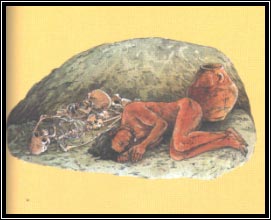Rock-cut tombs endured a number of transformations during the
Phoenician, Punic and Roman periods. It began from a simple round
chamber and shaft then evolved into a round chamber and rectangular
shaft. The third transformation consisted of a rectangular chamber
and enough space for other rooms on both sides of the shaft and
in the third century AD the ritual of rock-cut tombs was changed
to a one of collective burials into a hypogea.
 |
|
The burial of the dead
in most cases was in a crouched position. Although the above
tomb is a Prehistory one, the tomb chamber is very similar
to the early Phoenician tombs. Sometimes, the tomb was re-used
many times and the remains of the previous buried corpses
were left there. With the dead was buried also an amphora.
(Source: Malta: prehistory and temples, David H. Trump).
|
The arrival of the early Phoenicians in the Maltese islands around
700 BC, re-introduced the burying of the dead in rock-cut underground
chambers. This type of ritual had been practised constantly throughout
the 1,500 years of the prehistoric Temple culture in Malta, but
disappeared during the Bronze Age Period. The burying of the dead
in underground rock-cut tombs was widely used in the contemporary
Middle East cultures. Therefore, the Phoenicians probably brought
with them this ritual in the Maltese islands.1
The Phoenicians buried their dead inside round or oval chambers,
cut in the rock with access from the surface by entering in a
vertical shaft. The dead person was laid on its back in an extended
position and a number of pottery and jewellery items were buried
with him/her. In very rare occasions the dead was buried in a
specially-constructed stone or terracotta sarcophagus. Another
type of tomb used by the Phoenicians was the silo pit, a characteristic
of the Late Bronze Period. Cremation was practised too and it
seems to have been practised alongside inhumation throughout the
7th century BC, but later abandoned to be resumed in the 4th century
BC.2
In the 5th century BC during the early Punic period the tomb’s
plan was changed to a round chamber and rectangular shaft. In
the 4th and 3rd centuries BC, the tomb’s plan endured another
transformation, where the chamber too becomes rectangular and
rooms were cut on several sides of the shaft. 3
In nearly all the cases the tombs were cut in the rock to bury
the remains of a dead person which was laid on a smooth platform
on one side of a shallow trench which at first was positioned
transversally along the entrance to the burial chamber, later
at right angles to it. Probably the trench was used to put in
it the pottery such as amphorae and other burial items. Another
possibility could be that the trench was used to take up rain
during winter which managed to enter into the tomb through the
sealing slab. 4
 |
|
A Punic rock-cut tomb,
consisting of a deep rectangular shaft and a rectangular
chamber. The dead person is accompanied by a number of pottery
items.
|
This method of burying dead people in rock-cut tombs was not the
only ritual used in this period. There was also another ritual
and this was cremation and during this period it became more common,
where the cremated human remains were putted into special ceramic
urns which were introduced in pre-existing chamber tombs without
distributing the previous tomb contents. In some minor occasions,
a special type of tomb was cut out in the rock, where its plan
consisted of a very small square space, which could be reached
by a narrow shaft from the surface. 5
During the Imperial Roman Period the various necropolis outside
Melite (Mdina) continued to grow and expand. Apart from this,
older tombs some even going back to various centuries were frequently
opened and re-used. These Imperial Age tombs are very easily to
be recognized. This is because many of these tombs contained glass
blown such as bottles and phials a new technique which was introduced
50 BC. Tombs that of the Republican and Imperial phases contain
several cinerary urns covered with a plate with a lamp on top.
6
New burials were of both inhumation and cremation rites. Occasionally,
even amphorae were deposited containing bone remains of children.
Coins dating from the first to the second century AD occur on
rare occasions. It is a probability that by the second century
AD the ritual of isolated rock-cut tombs was not continued to
be practised. Therefore, people were probably making increasingly
wider use of sarcophagi buried in open fields or were burying
their dead in more larger collective underground systems like
the later Paleochristian hypogea. The ritual of burying dead people
in hypogea was probably in the early 3rd century AD if not earlier.
7



